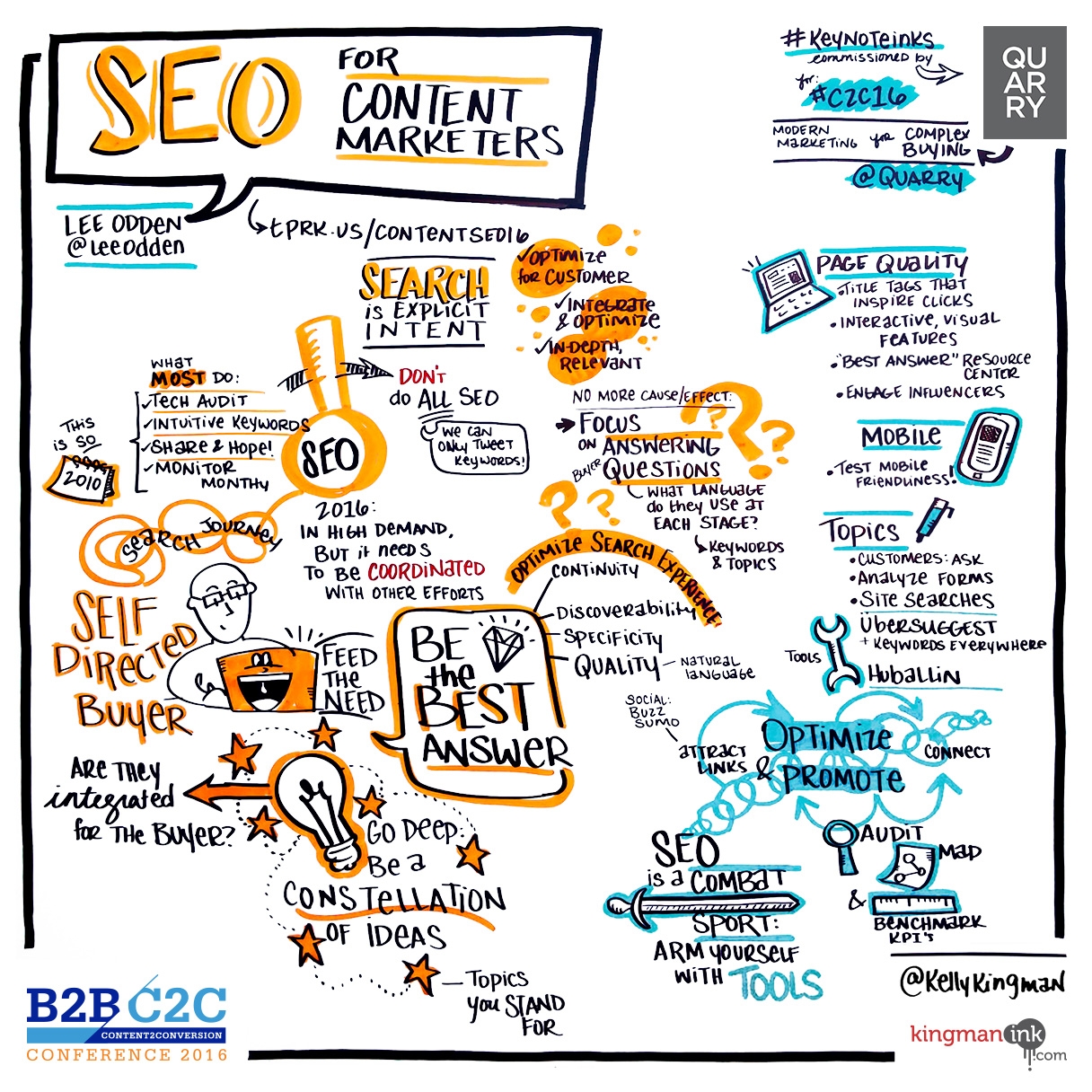Search Engine Optimization (SEO) remains a key element of a successful content marketing strategy, but today’s approach has to focus on answering buyers’ questions as they conduct research at various stages of the buying cycle. Buyers also need to use SEO to make content more accessible and easy to surface.
Lee Odden, CEO of TopRank Online Marketing, discussed the focus on buyers’ questions during his session on SEO strategy at the B2B Content2Conversion Conference in February. In separate sessions, Lauren McNiff, Senior Marketing Manager of Strategic Accounts for Glassdoor and Meagen Eisenberg, CMO at MongoDB, presented tips and best practices that zeroed in on SEO strategies to make content more accessible in order to drive traffic and increase conversions.
Odden said that many B2B marketers approach SEO the same way they did in 2010: make a list of keywords, use those keywords in titles, copy and links, then share on social media and hope for the best. That doesn’t resonate with today’s empowered buyers.
“There is a little bit of hating on SEO these days, but as long as there is Google, SEO will be a staple in the content marketing mix,” Odden said. “But B2B marketers need to broaden their thinking when it comes to SEO. Create content that answers users’ queries rather than just trying to rank for particular keywords.”
SEO has to create consistent topic credibility wherever your customers are, Odden said. This requires a balance of topic demand and relevance with the buyer stage to inform content topics.
During the awareness stage, for example, keywords should be broad, social topics should focus on trends, and the content should include blogs, webinars and social media, Odden advised. Further down the funnel, in the consideration stage, a mix of keywords that focus on comparisons with competitors and content centered around reviews and case studies is particularly effective.
Odden covered tips to improve search engine rankings overall, including:
- Leveraging keywords/topics in titles to inspire clicks;
- Including interactive and visual features that increase engagement;
- Providing comprehensive content on specific topics;
- Going beyond SEO keywords and categories to cover related topics as well; and
- Engaging your network — especially influencers — for social sharing.
Mobile is also becoming more critical to search rankings, Odden noted. He said marketers should consider creating a custom Google Analytics dashboard for mobile. He also recommends to ensure that all content is mobile-friendly, that mobile pages load quickly and also tested to confirm all links redirect correctly.
Make Your Top-Searched Content Easily Accessible
McNiff’s and Eisenberg’s sessions were a good complement to Odden’s block-and-tackling SEO presentation. They talked about using SEO strategies to make content more accessible, thereby driving more traffic and increasing conversions. Keeping all of your best content gated may make sense from a demand gen perspective, but ungating some of your top performing pieces can help more people find your content, McNiff said.
“People will be respectful of your position as a thought leader if they can easily access your content after it comes up in a search,” McNiff said. She did not advocate offering all content without a lead gen form, but advised B2B marketers to “be strategic in un-gating some of your content with a high SEO ranking.”
McNiff also suggested developing a content hub to make it easy for website visitors to find your content. If one piece of content comes up in a general search, she said, “the customer or prospect shouldn’t have to dig everywhere to find what they need.”
Using a lot of links can also help your content get found and shared. She pointed to Glassdoor’s Halloween costume contest last year, which had a number of links to submit pictures on social media. “We expected maybe 50 or 100 submissions, and we got thousands,” she said.
Scaling SEO To Meet Business Goals
While many B2B marketers are already creating content hubs and adding links to make their content more searchable, SEO can often take a back seat to other marketing activities for a variety of reasons.
MongoDB, which needed to scale its SEO and SEM programs to increase conversion rates and generate more traffic to its website had that issue.
The company’s SEO strategy was taking a lot of time and not producing the desired results, CMO Megan Eisenberg said. The company ultimately decided to implement Captora, a technology company focused on top-of-funnel marketing. Since bringing Captora in, 40% of MongoDB’s top keyword categories appear on the first page of search results.
MongoDB was also able to:
- Reduce keyword research by 4X;
- Increase monthly page deployment 10X, from 10 to 100 pages per month; and
- Streamline the approval process from one week to three days.
Eisenberg said even when a vendor partner is brought in, it is important to work closely with marketing ops to ensure that all keywords are attributed to specific content. In addition, she said that each piece of content should be linked to a campaign in Salesforce.
The next step, Eisenberg said, is to expand SEO to paid search. “We feel that is going to have even more of an impact this year.”







